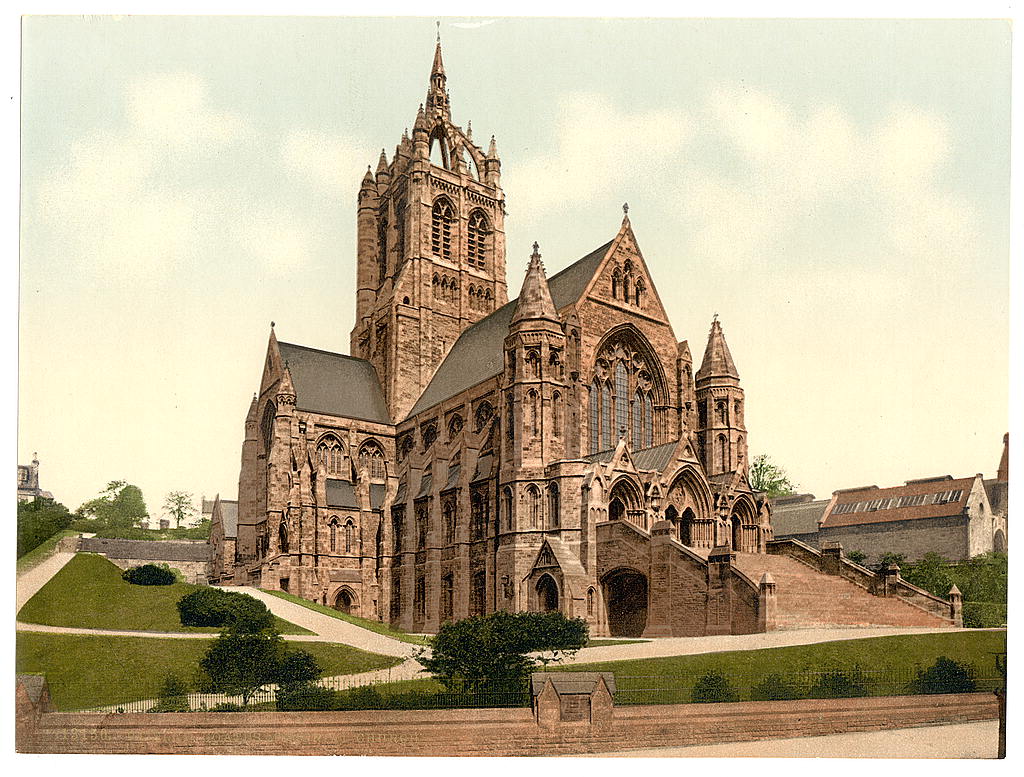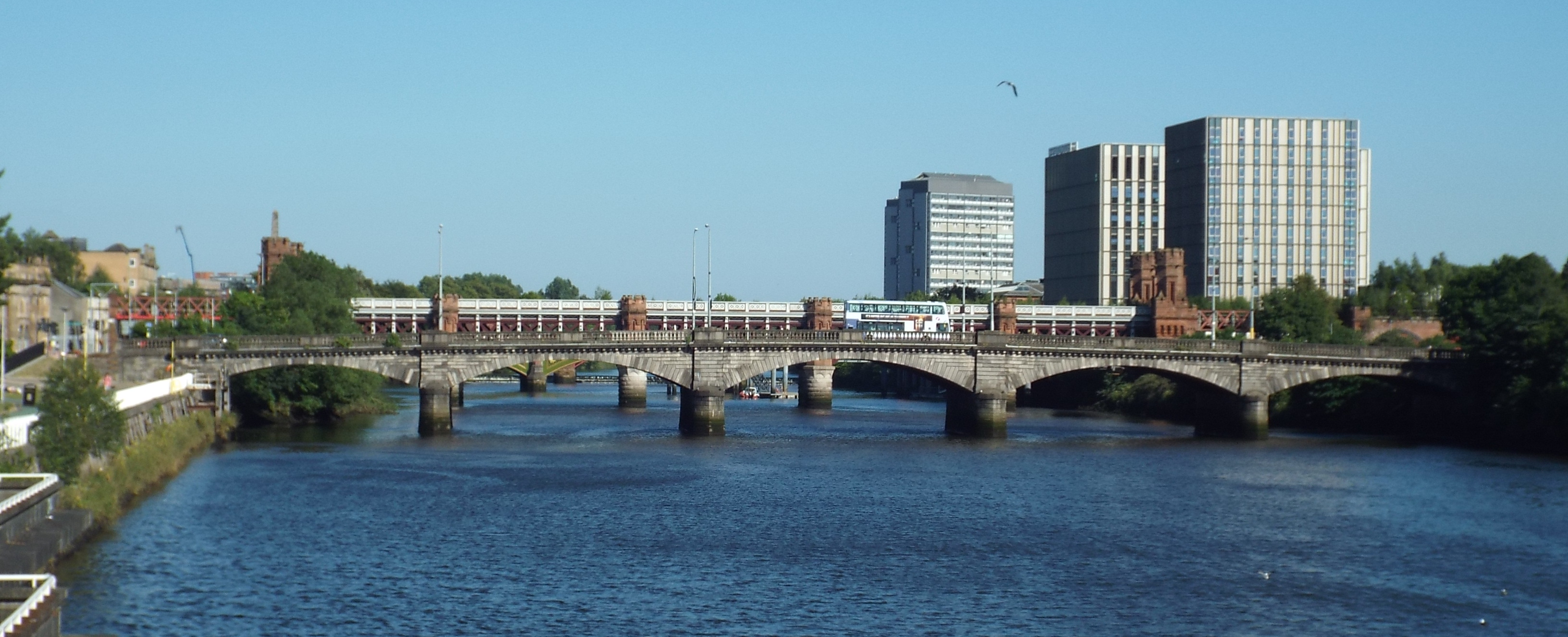|
Albert Bridge, Glasgow
The Albert Bridge is a road bridge that spans the River Clyde in Glasgow, Scotland, near Glasgow Green. The bridge opened in 1871. It links the Saltmarket in the city centre with Crown Street on the city’s south side. It is category A listed, and named after Queen Victoria's consort, Prince Albert. Previous bridges Albert Bridge is the fifth bridge to be built on the site in Glasgow. The first, built in 1794 and destroyed by flooding in 1795, was known as Hutcheson Bridge. The second, built in 1803, was a timber footbridge. The third, replacing the second in 1834, was a masonry arch bridge, designed by Robert Stevenson (grandfather to the author Robert Louis Stevenson). Stevenson’s bridge was demolished in 1868, and replaced with the fourth, a temporary wooden bridge. In 1871, that one in turn was replaced by the fifth: the Albert Bridge, which still stands today. Construction Construction of the Albert Bridge was managed by a group of trustees, who examined the conditi ... [...More Info...] [...Related Items...] OR: [Wikipedia] [Google] [Baidu] |
Albert Bridge, Glasgow, Viewed From The South-east, 2018-06-27
Albert may refer to: Companies * Albert (supermarket), a supermarket chain in the Czech Republic * Albert Heijn, a supermarket chain in the Netherlands * Albert Market, a street market in The Gambia * Albert Productions, a record label * Albert Computers, Inc., a computer manufacturer in the 1980s Entertainment * ''Albert'' (1985 film), a Czechoslovak film directed by František Vláčil * ''Albert'' (2015 film), a film by Karsten Kiilerich * ''Albert'' (2016 film), an American TV movie * ''Albert'' (Ed Hall album), 1988 * "Albert" (short story), by Leo Tolstoy * Albert (comics), a character in Marvel Comics * Albert (''Discworld''), a character in Terry Pratchett's ''Discworld'' series * Albert, a character in Dario Argento's 1977 film ''Suspiria'' Military * Battle of Albert (1914), a WWI battle at Albert, Somme, France * Battle of Albert (1916), a WWI battle at Albert, Somme, France * Battle of Albert (1918), a WWI battle at Albert, Somme, France People * Albert (given n ... [...More Info...] [...Related Items...] OR: [Wikipedia] [Google] [Baidu] |
Paisley, Renfrewshire
Paisley ( ; sco, Paisley, gd, Pàislig ) is a large town situated in the west central Lowlands of Scotland. Located north of the Gleniffer Braes, the town borders the city of Glasgow to the east, and straddles the banks of the White Cart Water, a tributary of the River Clyde. Paisley serves as the administrative centre for the Renfrewshire council area, and is the largest town in the historic county of the same name. It is often cited as "Scotland's largest town" and is the fifth largest settlement in the country, although it does not have city status. The town became prominent in the 12th century, with the establishment of Paisley Abbey, an important religious hub which formerly had control over other local churches. By the 19th century, Paisley was a centre of the weaving industry, giving its name to the Paisley shawl and the Paisley pattern. The town's associations with political radicalism were highlighted by its involvement in the Radical War of 1820, with s ... [...More Info...] [...Related Items...] OR: [Wikipedia] [Google] [Baidu] |
Category A Listed Buildings In Glasgow
Category, plural categories, may refer to: Philosophy and general uses *Categorization, categories in cognitive science, information science and generally * Category of being * ''Categories'' (Aristotle) * Category (Kant) * Categories (Peirce) * Category (Vaisheshika) * Stoic categories * Category mistake Mathematics * Category (mathematics), a structure consisting of objects and arrows * Category (topology), in the context of Baire spaces * Lusternik–Schnirelmann category, sometimes called ''LS-category'' or simply ''category'' * Categorical data, in statistics Linguistics * Lexical category, a part of speech such as ''noun'', ''preposition'', etc. *Syntactic category, a similar concept which can also include phrasal categories * Grammatical category, a grammatical feature such as ''tense'', ''gender'', etc. Other * Category (chess tournament) * Objective-C categories, a computer programming concept * Pregnancy category * Prisoner security categories in the United ... [...More Info...] [...Related Items...] OR: [Wikipedia] [Google] [Baidu] |
Bridges Across The River Clyde
A bridge is a structure built to span a physical obstacle (such as a body of water, valley, road, or rail) without blocking the way underneath. It is constructed for the purpose of providing passage over the obstacle, which is usually something that is otherwise difficult or impossible to cross. There are many different designs of bridges, each serving a particular purpose and applicable to different situations. Designs of bridges vary depending on factors such as the function of the bridge, the nature of the terrain where the bridge is constructed and anchored, and the material used to make it, and the funds available to build it. The earliest bridges were likely made with fallen trees and stepping stones. The Neolithic people built boardwalk bridges across marshland. The Arkadiko Bridge (dating from the 13th century BC, in the Peloponnese) is one of the oldest arch bridges still in existence and use. Etymology The ''Oxford English Dictionary'' traces the origin of the wo ... [...More Info...] [...Related Items...] OR: [Wikipedia] [Google] [Baidu] |
Earl Of Wessex
Earl of Wessex is a title that has been created twice in British history – once in the pre-Conquest Anglo-Saxon nobility of England, and once in the Peerage of the United Kingdom. In the 6th century AD the region of Wessex (the lands of the West Saxons), in the south and southwest of present-day England, became one of the Anglo-Saxon kingdoms (one of the components of the so-called Heptarchy); in the tenth century the increasing power of the Kingdom of the West Saxons led to a united Kingdom of England. First creation (c. 1019) Wessex was one of the four earldoms of Anglo-Danish England. In this period, the earldom of Wessex covered the lands of the old kingdom of Wessex, covering the counties of the south of England, and extending west to the Welsh border. During the reign of King Cnut, the earldom was conferred on Godwin at some time after 1020. Thereafter, Godwin rose to become, in King Edward's time, the most powerful man in the kingdom. Upon Godwin's death in 1053, the ... [...More Info...] [...Related Items...] OR: [Wikipedia] [Google] [Baidu] |
Victoria Bridge, Glasgow
Victoria Bridge is a category A listed road bridge spanning the River Clyde in Glasgow, Scotland. Victoria Bridge is the oldest surviving bridge in Glasgow, lying at the foot of Stockwell Street in the city centre. History Victoria Bridge is built on the site of the first recorded bridge over the Clyde; a timber bridge believed to exist in 1285 and described as "Glaskow bryg, that byggt was of tre" in Henry the Minstrel's epic poem on Sir William Wallace. In 1345 Bishop William Rae replaced the timber bridge with the Bishop's Bridge, located on the same site. Bishop's Bridge was originally wide, but was widened by in 1777. By 1851 Glasgow's population had risen to 329,000 having doubled in the previous 25 years and the old bridge couldn't cope with current demands, and needed to be replaced. Construction A new masonry arch bridge was designed by James Walker and constructed by William Scott, although some references name William York, Esquire as the builder. The bridge h ... [...More Info...] [...Related Items...] OR: [Wikipedia] [Google] [Baidu] |
George Edwin Ewing
George Edwin Ewing (8 July 1828 – 26 April 1884) was a Scottish sculptor. He was born in Birmingham, the son of sculptor James Ewing and the brother of sculptor James Alexander Ewing. He grew up in Edinburgh and Glasgow and learned his trade in Liverpool and London, including in the modelling room of Covent Garden Theatre, before setting up in business in Glasgow in 1859. He then spent some time in Rome in the 1860s studying under the sculptor John Gibson before returning to Glasgow in 1862. He went on to be the most successful Scottish sculptor of his time. Whilst his reputation stemmed from his marble busts of prominent Scots and the Royal Family, his most well-known commission was the bronze statue of Robert Burns in George Square, Glasgow, created in 1874–77, which was later enhanced with three bronze panels by his brother James in 1885–7. Whereas much of his work on public buildings has been lost during demolition, significant works remain to be seen in the cemeteries ... [...More Info...] [...Related Items...] OR: [Wikipedia] [Google] [Baidu] |
Hanna, Donald & Wilson
Hanna, Donald and Wilson were a Scottish engineering and shipbuilding firm which flourished in the Victorian era. Reid & Hanna The general engineering firm of Reid & Hanna was founded in 1816 in Paisley, Scotland. Paisley had become an important industrial town in the late 18th century. By the mid-19th century weaving would become the town's principal industry. Of course the textile industry created opportunities for local machine factories and / or repair shops. Reid & Hanna might have been a company that just catered to the needs of the local textiles industry. Paisley was also a traditional center for shipbuilding. It is connected to the Clyde by the modest River Cart. When ships became too big for the River Cart, the local maritime industry adapted to building small vessels, specializing, or building "knock down" vessels. In July 1834 Reid & Hanna were reported to have finished a very beautiful sheet iron gig for use on the Paisley Canal, together with Walker firm. Two ... [...More Info...] [...Related Items...] OR: [Wikipedia] [Google] [Baidu] |
River Clyde
The River Clyde ( gd, Abhainn Chluaidh, , sco, Clyde Watter, or ) is a river that flows into the Firth of Clyde in Scotland. It is the ninth-longest river in the United Kingdom, and the third-longest in Scotland. It runs through the major city of Glasgow. Historically, it was important to the British Empire because of its role in shipbuilding and trade. To the Romans, it was , and in the early medieval Cumbric language, it was known as or . It was central to the Kingdom of Strathclyde (). Etymology The exact etymology of the river's name is unclear, though it is known that the name is ancient: It was called or by the Britons and by the Romans. It is therefore likely that the name comes from a Celtic language—most likely Old British. But there is more than one old Celtic word that the river's name could plausibly derive from. One possible root is the Common Brittonic , meaning 'loud' or 'loudly'. More likely, the river was named after a local Celtic goddess, '' Clōta ... [...More Info...] [...Related Items...] OR: [Wikipedia] [Google] [Baidu] |





.jpg)